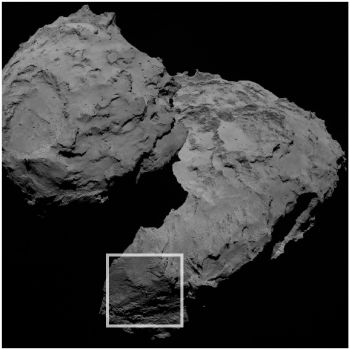
The three curious boulders are found in the Aker region of Comet 67P/C-G, on the comet’s large lobe (in the centre of the region outlined). Credits: ESA/Rosetta/MPS for OSIRIS Team MPS/UPD/LAM/IAA/SSO/INTA/UPM/DASP/IDA
Scientists from Rosetta’s OSIRIS team have discovered an unusual formation of boulders in the Aker region on the large lobe of Comet 67P/Churyumov-Gerasimenko. At first glance they are reminiscent of so-called “balancing rocks” on Earth.
Of the three boulders, the largest (labelled with a ‘3’) has a diameter of approximately 30 metres. In an image taken on 16 September 2014 (below), it stands out as having only a very small contact area with the comet’s surface. It also seems to be perched on the rim of a small depression.
“We had noticed this formation already in earlier images, however, at first the boulders did not seem to differ substantially from others we had seen,” says OSIRIS scientist Sebastien Besse from ESA, who first noticed the formation.
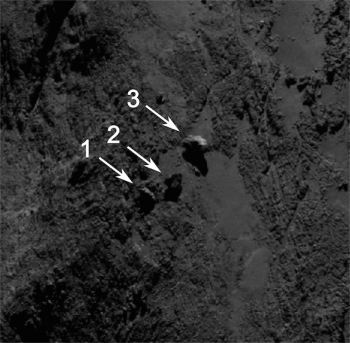
Image of the boulders taken by OSIRIS on 16 September 2014 from a distance of 29 km. The image scale at this distance is around 0.5 m/pixel and the image measures about 292 m across. Boulder 3 measures approximately 30 m across.
Credits: ESA/Rosetta/MPS for OSIRIS Team MPS/UPD/LAM/IAA/SSO/INTA/UPM/DASP/IDA
Similar geological formations are also found on Earth. Balancing rocks touch the underlying ground with only a tiny fraction of their surface and often look as if they may tilt or topple over any moment. Some can actually be rocked back and forth and are then referred to as “rocking stones.” Many of these boulders are so-called “erratics” that travelled to their current location within glaciers. In other cases, wind and water eroded softer material in the local bedrock, leaving only the more resistant material behind.
“How this apparent balancing rock on Comet 67P/C-G was formed is not clear at this point,” says OSIRIS Principal Investigator Holger Sierks from the Max Planck Institute for Solar System Research (MPS) in Germany.
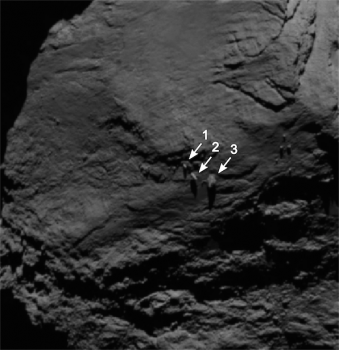
Image of the boulders taken by OSIRIS on 16 August 2014 from a distance of 105 kilometres. The image has a resolution of about 2 m/pixel. Boulder 3 measures approximately 30 m across.
Credits: ESA/Rosetta/MPS for OSIRIS Team MPS/UPD/LAM/IAA/SSO/INTA/UPM/DASP/IDA
One possibility is that transport processes related to cometary activity played a role, causing such boulders to move from their original site and reach a new location.
Scattered boulders are seen in many places on the comet’s surface, sometimes in otherwise relatively smooth regions. One of the largest – Cheops – measures approximately 45 metres in size and sits in the middle of the smooth part of Imhotep on the underside of the comet’s large lobe. In other regions, it is more common to see rubble piles comprising hundreds of boulders.
“Interpreting images of the comet’s surface can be tricky,” adds Sierks. Depending on the viewing angle, illumination, and spatial resolution, very different and sometimes even misleading impressions are created.
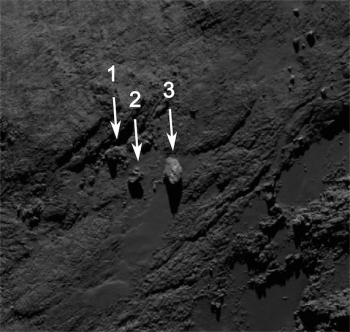
Image of the boulders taken by OSIRIS on 19 September 2014 from a distance of about of 29 km. The image scale at this distance is about 0.5m/pixel and the image measures about 285 m across. Boulder 3 measures approximately 30 m across.
Credits: ESA/Rosetta/MPS for OSIRIS Team MPS/UPD/LAM/IAA/SSO/INTA/UPM/DASP/IDA
For example, in an image taken on 16 August 2014 from a distance of 105 kilometres, one of the smaller boulders [labelled ‘2’] in the balancing rock formation appears to be protruding like a pillar. However, this impression is not confirmed in an image of the same region taken on 19 September 2014 from the much closer distance of 29 km. Similarly, thanks to the change in viewing geometry between images, the appearance of the large boulder also changes quite dramatically, even between the 16 and 19 September images.
Further imaging of these formations should help provide more insight into their true nature and maybe even their origin.
Unlabelled versions of the images are also provided below (all credits: ESA/Rosetta/MPS for OSIRIS Team MPS/UPD/LAM/IAA/SSO/INTA/UPM/DASP/IDA):

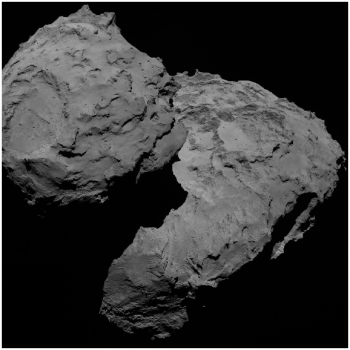
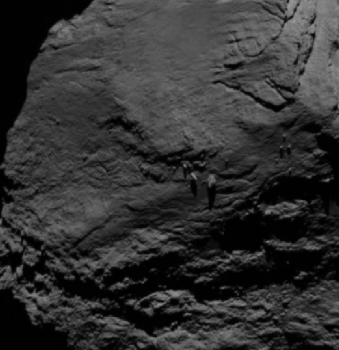
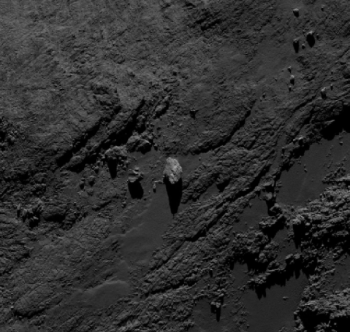
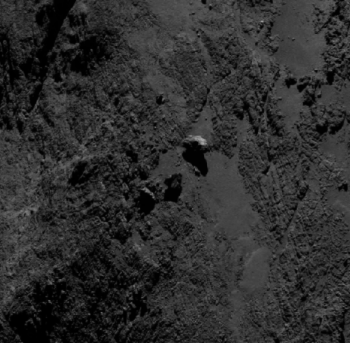








Discussion: 37 comments
These rocks are very nice, but it is very,very strange and interesting the presence of stratification near the rocks! Why no one speaks about? I am a geologist e this stratification has not a explication on a comet! Luigi
Luigi,
I was about to make the same comment myself, so obvious is the stratification of the area surrounding these balancing rocks.
I pointed out in my first comments way back in September, shortly after the first images of the nucleus were published, that we could see rock stratification at all scales, all over the nucleus. I was told at the time that any comparison with Earth-like features was ridiculous, since the conditions reigning on 67P were too extreme to enable us to believe the evidence of our eyes…
I note with satisfaction that Earth-like comparisons are now being made routinely, even by mission scientists in official press-releases and that even the r-word, “rock”, is also now being used, and without inverted commas…. This is progress indeed in the direction of simple common sense.
I’m pleased, above all, to hear the opinion of a geologist, as someone who is perfectly qualified to give a scientific reading of these images. It would be interesting to hear the opinion of other professional geologists, to see if they confirm this reading.
The ‘r-word’, THOMAS 😉
Like Harvey’s ‘rock-ice’ more. Of course, there should be more ‘rocky’, secondary ones, like those dry remains at tips of the geography. [And trapped boulders, at accretion phases, too].
ERRATA: heard rock-ice from Robin.
Logan, the only “r-word” is “rock”. “Rock-ice” is a figment of standard theory imagination, dreamed up to attempt to save standard theory expectations despite the clear ocular evidence of stratified rock. If you, or anyone else, can provide links to images of so-called “rock-ice” resembling the stratified formations we’ve been seeing all over 67P in every image released over the past 10 months, I for one be delighted to see them. And could the geologists on the blog please explain what “rock-ice” is supposed to be. I’ve found no reference to it anywhere; the Wikipedia entry for “rock-ice” produces this: https://en.wikipedia.org/wiki/Rock_Ice
Please explain how a stratified rock has a density of only 470 kg/m^3,
If one is determined to see the tributaries of the Amazon river in the tea leaves that have settled at the bottom of a tea cup, then that is exactly what is seen.
What about the actual physical evidence itself, the stuff that is measurable, and not conjured by an over active imagination.
You conveniently ignore the evidence because it contradicts your faith that the comet must be made of rock.
But rock boulders Holger rather than lumps of ice would you say ?
Ejecta from a cryovolcano? Fragments from some tectonic activity between the lobes? Chunks of condensate formed as escaping gases froze?
Or chunks assembled from assemblage of refractory “dirt flakes” that make up the non-volatile component of 67P/Churyumov-Gerasimenko?
Like so much other ‘big science’, this mission inspires many more questions than we had before. Some of them may even be answered 😉
Thanks, Emily
a strange curiosity inside rosetta
By the erosion that is meant to be happening, there should have been either noticeable changes on or around these “rocks” by now, or solar forces should have caused them to unbalance these balanced rocks.
Additionally, with all the small “rocks” strewn all over the comet, surely one would show evidence of being moved or changed due to erosion (presumed sublimation induced erosion)
The only conclusion I can come up with is that there is little to no surface erosion, and these “rocks” are evidence of a comet wide disruption due to partial break up or stretch or both.
These boulders remind me of Obelix’s menhirs. Maybe these boulders should be called “Tekhenu”, the ancient Egyptian name for vertical monolithic structures that Obelisks and menhirs were fashioned on. ..
Even more interesting are the even larger boulders on the amphitheatre near the North Pole. Those can be traced back and matched to where they broke off the edge of the candidate site A, as it was when deciding on landing sites.
Is it just me or do others agree that this is a non story? Is there really anything interesting about a random selection of 3 objects located close together? Does the Osiris team have nothing better to do now that Rosetta is further away from 67P. come on team – you can do lots better than this!
ESA’s Outreach needed awe. Desesperatly. Sensorial kind.
Hi Graham,
I strongly disagree. These three rocks have been flagged as very interesting because they are not random. There is no expectation of these kinds of formations, and it isn’t an isolated case. The three rocks are very similar to each other, and give hints that they were initially part of one rock, but quite different from the surface they are sitting on. It is like as if a Cheops size rock was transported from another part of the comet, broke into at least three pieces and landed there. On top of that, nothing has been eroded or moved since. I find that intensely interesting, from a scientific viewpoint.
Caution! The presented individual images are about 8 percent of a full OSIRIS frame. Are you not afraid to share too much, OSIRIS team? 😉
Way back in October of last year, Matt mentioned that there were several kilos per second of water sublimating from the comet at that time, and that this would increase to hundreds of kilos per second as the comet reaches perihelion. Has anyone mentioned or updated these figures since then? Anyway, if it’s hundreds at perihelion, let’s then say conservatively it’s sublimating 75 kilos of water (plus all that dust) per second right now. That’s 4500 kilos of water per minute, 270,000 per hour, 6,480,000 per day (roughly 3 Olympic sized pools), and 45,360,000 kilos of water sublimating off the comet per week. Now granted, that’s not that much given the size of P67, but still, seems strange that for the amount of activity and water volume loss there haven’t been any before/after pictures to show us of more obvious landscape changes with clear visible evidence of some kind of sublimation. Perhaps Osiris will provide this at some point after their long delay for dramatic effect. And I get confused now when I hear the word “rock” attributed to the comet by consensus scientists or commenters. P67 is supposed to be ice and dust according to mainstream theory, but I suppose it’s a bit of a pickle to explain what the rocky stuff is since it does look exactly like rock, stratified or otherwise, and the rock covers every surface of the comet that’s not dust. Rock doesn’t fit the comet creation story or sublimation though, so seems they mean rock as in glued together dusty paper machete or something (sorry Luigi, move along, nothing to see here). Regardless, I just keep getting the feeling that P67’s mythical labels aren’t the only myths being attributed to it, and that there still seems to be a huge gulf between what this comet (and all other comets?) is supposed to be vs what it actually is.
470 kg / m^3. It isn’t rock.
Yes yes, but as has been discussed repeatedly, that would also mean it’s not ice and dirt, which is basically twice the density of 470 kg / m^3. So if you’re going to rule out rock with this argument, you need to also rule out ice and dirt. But there are so many things that aren’t adding up with this comet that I’d be very hesitant to come to any rock solid (sorry, couldn’t resist) conclusions based on any one finding.
Sorry, that’s just wrong. Ice plus dust plus voids. Most of the dust collected in the close fly-bys was very light stuff, ~1 kg m^3, so not much more than 1000 kg m^3 for the “solid” material. I’ll leave you to figure out how much of the comet must then be empty space to account for the measurement of 470 kg m^3.
One thing it does rule out, I think we can all agree, is that this thing is solid rock. And don’t forget that that “one measurement” is crucial in determining the gravity of the comet, and therefore calculations of its orbital maneuvers.
They seem to be doing pretty well based on those measurements so far.
Pumice is the only EU assertion that can plausibly partially reconcile their theories with measurement. One other major problem is that the surface is not eroding based on images taken months apart. Electrical machining implies surface erosion to generate ions. This is not happening. It also is a problem for theories of near surface sublimation erosion. These boulders are near the equator so have been getting increased overhead insolation, and yet no measurable erosion in months. My explanation is that deeper subsurface volatiles are evaporating from pores just making the substrate more porous rather than eroding it.
“Ice plus dust plus VOIDS” = that density?
Well then, rock plus voids could as well, so this is a non argument.
How much of the comet do you think is made of light dust? (that is, if the light dust is actually original to the comet as opposed to processed to become light as it leaves the comet) Would have to just guess. But let’s say the comet is composed of a significant amount of light dust. I think we can all agree it’s not ALL light dust, right? If so, then how do you know that the rest of the comet density couldn’t be balanced out by rock as opposed to ice and still meet this overall density figure? Rock would simply require a higher percentage of light dust than ice would.
Sovereign slave: so you do agree that it is not ALL rock?
Kamal Lodaya says: so you do agree that it is not ALL rock?
Hi Kamal, got no idea. All we can see is what looks like dust and what looks like rock. In my book, most things that so obviously look like something in nature usually are those things, and nature is not normally out to trick us with bait and switch tactics. We’ve seen distance and very very close pictures of the comet, and I’d wager that we’re seeing de facto rock. What to make of the density measurements? Not sure. But when you boil it all down, this debate is really about two assumptions: sublimation or electric force? Sublimation is certainly a convenient assumption to explain the coma, but it’s not really been useful to explain anything else about the comet, and it’s very odd that the required ice is so bashful. It’s like playing Where’s Waldo without the requisite Waldo, but perhaps he’s hiding on the next page. Electrical theory is elegant in that it provides a uniform theory of the cosmos, it makes sense in a broad way, it can be matched with many observations, yet it is not proven. So, pick your poison, and understand that you believe what you believe because that’s what you have chosen to believe.
And you could have completed that calculation to show that, were the ice lost evenly over the surface of the whole comet (~30 km^2), then this would equate to a loss of about 4mm from the surface per week. Given the distance Rosetta is now having to orbit at, for safety reasons, perhaps you could explain what instrument might notice this?
Ianw 16,
Does it seem likely that the erosion by what ever method would be equal across the whole surface?
Also there are many features like the rocking boulders, that if they were sublimating, then presumably removal would be on all sides, so your 4mm per week, if it were right, would be at least double in these instances. Also with so much surface above the ground you might expect the boulders and protrusions would get hotter, and maybe sublimate quicker if that is indeed the way they are eroding.
There has not been much data from the dark side of the comet either, but it seems to be quieter.
Some areas seem to have been producing jets for much longer than others, which would mean there has been more erosion at localized areas.
Ok the resolution of pictures has been restricted by how close we have been to the surface and for how long, but some of the NAVCAM pictures have shown changes in the dust covering and other features over time.
So I would expect the OSIRIS team to already have some decent before and after erosion pictures.
These might give us a bit more information, on the nature of the erosion and the rate at which it happens, that should then help us with your question.
Shame is we don’t have those pictures.
Regards
ReIanw 16
Just a further thought, if we cannot see erosion on these boulders when the Osiris pictures are available, then maybe we have to look again at why.
For instance, If you believe the boulders are made of ice and dust, then they should be sublimating away to a pile of sand right before our eyes.
If its not sublimating, then you have to ask the question what are they made of?
Could they be rock after all.
regards
That’s certainly one of the science objectives. So I’m not too surprized, that we don’t have seen most of these images yet, considering the general embargo timespan on Rosetta science data.
Imagine you’re dedicating 20 years of your life almost exclusively to one high-risk once-in-a-lifetime chance of success, and one day before your work is completed, someone else earns the merits for all your efforts. That’s not easy for everyone.
Although I disagree with this point of view, since any paper based on OSIRIS data is a success for the OSIRIS team, and maybe even a bigger one, since multiplied, without need to do everything themselves. But that’s easy to tell from outside…
Agreed w16 and the same would apply, with a different calculation, to the plasma discharge model. If we saw huge chunks removed from the surface the comet would be gone in a handful of orbits.
These three rocks used to be one rock which broke apart as it landed on the boundary line of Aker and Khepry. If you compare the three, toggling between both of the close-up photos, you can see that all three exhibit a longitudinal scallop. The cross-sectional dimensions of the scallop and its frilly edge are very similar for the smaller two of the three. It can be inferred for the larger rock via the curved shadow at its top. The width, depth and degree of curving across the scallop is the same in all three cases.
The only difference between the scallops is in their lengths but seeing as they run across the length of each rock, that is simply a function of the size of each rock. That is in turn dependent on the weak points in the original rock that broke on landing. The fact that all three scallops run the length of all three rocks and not just a part of each is, therefore, evidence that they were once joined as one rock. Further evidence is that the scallops are all turned, essentially upwards and very roughly in line with each other. Whilst one might expect them to roll randomly on landing, the fact that they are in this configuration strongly suggests a link. In fact, most of the misalignment of the scallops, as far as it goes, appears to be slight tipping and twisting to the surface because they can’t balance in their exact former configuration.
I presume the OSIRIS team haven’t realised this since it would be the most interesting property of the observed grouping. After all, Emily refers to it as an “unusual formation”, doubtless based on the questions the rocks are posing for the scientists.
They do mention transport processes related to cometary activity, but it’s perhaps telling that they didn’t elaborate on exactly which processes. The only paper that I know of so far that has tackled the transport of such large rocks is Thomas et al, Jan 2015. This paper tentatively cited explosive sublimation as a possible cause for the displacement of a single large slab. They had difficulty enough in reconciling that idea with the 70-80% porosity of the comet and it was for a large, flat slab that was dumped right next to its original seating. As for boulders that have been transported hundreds of metres, there has been no suggestion that this process is at play.
The most likely process for the transport of these three rocks, or one original rock, is via spin-up of the comet to the point where it shed large slabs and associated boulders. The reasons for this are as follows.
It’s highly significant that these three rocks are aligned along the rotation plane of the comet. That’s because the original, whole rock was in a suborbital flight trajectory, travelling backwards down the rotation plane before it landed. On landing, the three pieces were naturally spread out along the direction of travel which is the reverse direction along the rotation plane.
The reason for the original rock to have been in a suborbital trajectory is that it was ejected from the Aten region or possibly the Imhotep region as the vast slabs were detached from these areas during comet spin-up. Most detritus escaped at escape velocity with the slabs but the few rocks given a chance backwards velocity kick would not have attained escape velocity. They would have travelled backwards down the rotation plane as the comet rotated beneath them. On landing, any breakage would result in the rotation plane alignment of the fragments. The same would happen to any scree sitting on the boulder itself.
This scenario is abundantly clear in the rocks in the amphitheatre/site A which Marco cites above: two rocks which can be unequivocally matched to their seating positions 170 metres up the rotation plane and their associated scree, flung down the rotation plane behind them on landing. The three rocks pictured in this post are following the same behaviour, though in a slightly less neat fashion.
As long as the OSIRIS team scrutinises the features in its pictures while assuming them to be separate, unrelated morphological phenomena they will remain completely in the dark. This blog post is a perfect illustration: without regarding the three rocks in the light of the processes that arise from spin-up and subsequent stretch, the team will not interpret these particular pictures correctly. The fact that they haven’t seen the obvious relationship between the rocks shows that they are quite blinkered. The scallop running through all three rocks is a gift in terms of starting to piece things together (literally in this case). But this obvious relationship has been missed due to regarding the pictures through the lens of preconceived notions, such as the comet being a contact binary or a single eroded body- or with nothing much in mind at all.
Very interesting image, but really a scrap tossed grudgingly from the top table. I am hoping that, following in the footsteps of the brilliant NAVCAM team, we see a mass release of OSIRIS images at the end of the month, when one should be happening, but I really don’t think it’s going to happen, because it really does seem that the OSIRIS team doesn’t care about the public and media frustration, and interest in their images, and they apparently don’t care that ESA itself is frustrated with them either. They will sit on their images until they are absolutely forced to release them. Take this latest image for example: taken last *September*, eight *months* ago, it shows a few rocks standing on end, which is interesting, yes, but really, out of all the images they must have taken of crumbling cliffs, vents, pits, landslides, layers and more, they picked a picture of a few rocks which shows nothing else. And then, going by the comments I’ve read from people elsewhere with way more image processing knowledge than I, they scaled it down and degraded it so much it was little better than the navcam images anyway. So while other agencies and missions are happy to release images of Ceres, Mars, Pluto, Saturn, the Moon just days or even hours after they were taken, and the Rosetta mission’s own NAVCAM team release images almost daily, the OSIRIS team refuses. And while I have every sympathy with the argument that they initially needed an agreement in place to ensure they had – like the scientists on other missions – sufficient time to work on the images themselves so they can do their research and write their papers etc, they have had that time, and then some, and still refuse to release even a *weekly* image, which they originally said they were going to do, if I remember correctly. That is a choice they have made, which goes against the spirit of their own agreement, and is against the best interests of ESA itself. If the OSIRIS team releases a ton of images at month’s end I will be delighted, and will give them full credit for it, and blog gushingly about the images. But if, as I suspect, they do not release the images as they are supposed to, well, that will speak for itself. We’ll have to wait and see. I have my fingers crossed for a big and very welcome surprise 🙂
Under-surface fluids from the base of the ‘rocks’. Specially from the big one.
Even more beautiful and intriguing are the ‘low lands’ nearby. There are leveling processes acting there at each perihelion.
Maybe too much salts.
Extruding from a hundred meter deep layering?
Is that a small lahar delta, at left of boulders?
https://blogs.esa.int/rosetta/files/2015/05/ESA_Rosetta_OSIRIS_20140816_labelled-339×350.png
One has to be careful with assuming the ‘rocks’ are in fact balancing – due to the shape of the body the surface gravity will point in some very odd directions and may in places even be parallel to the surface. I was hoping that the Rosetta scientists would publish a surface gravity map using the shape model they have so we could get a better idea of what is ‘up’ in different parts of the comet.
Are there no pictures with a side-on view of these rocks? Maybe form earlier when closer passes were made?